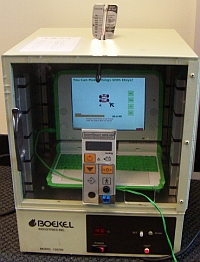While you might be feeling the heat of summer, the One Laptop Per Child team is putting the XO computer through its paces with two extreme tests of its durability to guarantee its successful usage with children in the developing world.
The first test is subjecting the OLPC XO to extremes of heat. Funny enough, I know a little bit about building computers to withstand high heat environments. In my day job I helped with the creation of a desert computer that would work in the Sahel - the edge of the Sahara desert beyond Timbuktu.
We developed a computer that could run at 50C (122F) reasonably well but it was no Children's Machine XO. It wasn't subjected to the computer torture that Mary Lou Jepsen is inflicting on a hapless BTest-3 machine. To quote Walter Bender:
Mary Lou Jepsen has instructed UL to test our laptop for a 50C (122F) operating temperature. Typical laptops are only tested to 35C (95F) or 40C (104F), which is unacceptable for the children who will be using our laptops in hot temperatures (e.g., in direct sunlight and of course without air conditioning).Indeed, though just make sure its not a laptop you need because it will melt from the inside out as the processor (or battery) flames out mid-way through the test.Mary Lou and Tracy Price are also running a simple bake test at the OLPC office, pictured above. The laptop is running days at 52C (125F), and nights at 22C (72F). UL and Quanta are doing more extensive testing, but shown is a laptop, running the eToys demo that sits in the oven night and day. Try that with a conventional laptop!
Another test you might not want to try using a conventional computer is the cat test. This is where you subject a notebook to the intense scrutiny of a pussy cat and see if it can survive the paw prints of feline fascination.
As part of the iCommons Summit 2007, SJ Klein, Director of Content, One Laptop Per Child, performed the dreaded "cat test" with an OLPC XO:
Yes, its One Laptop Per Cat!


The OLPC really needs to be subjected to the GOAT and RAT tests, as these are much more common animals than cute kitty cats in the developing world, and they like to chew on cute little PCs, cables etc.
I question the "One Laptop Per Cat" user requirements process.
I mean, it doesn't even have a mouse.
Sorry
Don't forget mildew. It's not something we need to worry about in temperate climates, but in high-humidity climates it can be serious.
And back to fauna - and on a more serious note:
I grew up in Venezuela - and cockroaches both big and small love to get into those electronics. Particularly the small ones - ("chiripas" as we called them).
Sounds like a 'Fear Factor' stunt, but would be worth it to put into a tank with a ton of cucarachitas and see if they can get in.
However inured one gets to them in the tropics, few things more disgusting than having one popping out of the keyboard while you're typing. Yes - I speak from personal experience.
Alec
Alec,
"and cockroaches both big and small love to get into those electronics. Particularly the small ones ... few things more disgusting than having one popping out of the keyboard while you're typing"
Not likely with OLPC XO as the machine is pretty much covered up. However, if you look at Intel's Classmate PC, the cooling vents look very much like an 'invitation' for some creepy-crawlies...
The cat in the video was uninterested in the XO. But a friend of mine had a cat that would watch tv. When an animal came on it would run up to the screen and try to touch it with its paw. Obviously someone needs to design software for cats, so they can have some fun with the machine. Maybe even teach them to program.
OLPC is "cooking XO's between 40 and 60°C, which are the upper limits when it comes to charging NiMh batteries. So far, testing shows positive results, with the laptops operating as-normal at 50°C."
http://blogs.ubuntu.org.au/shenki/26
I don't know how to say it, but I have never agreed with this kind of testing. I don't know why people keep doing this if they know it isn't the right thing.